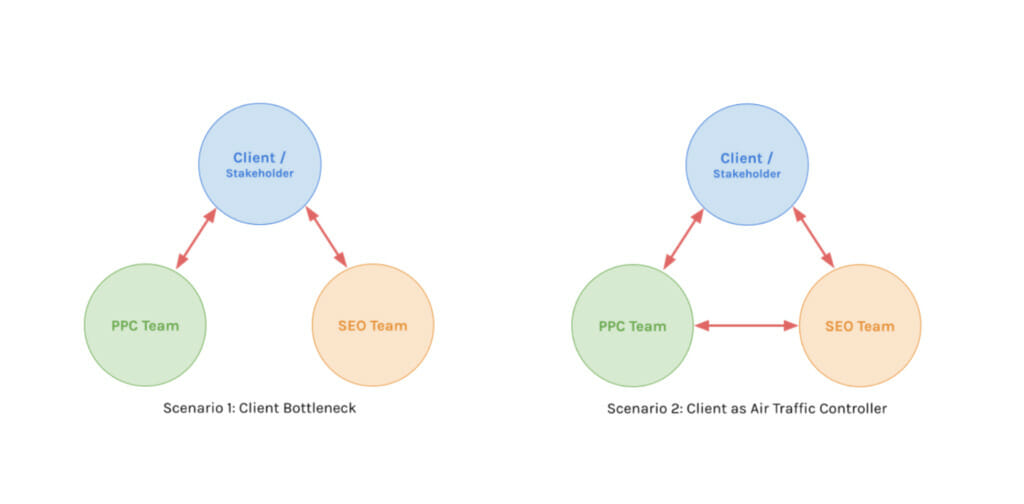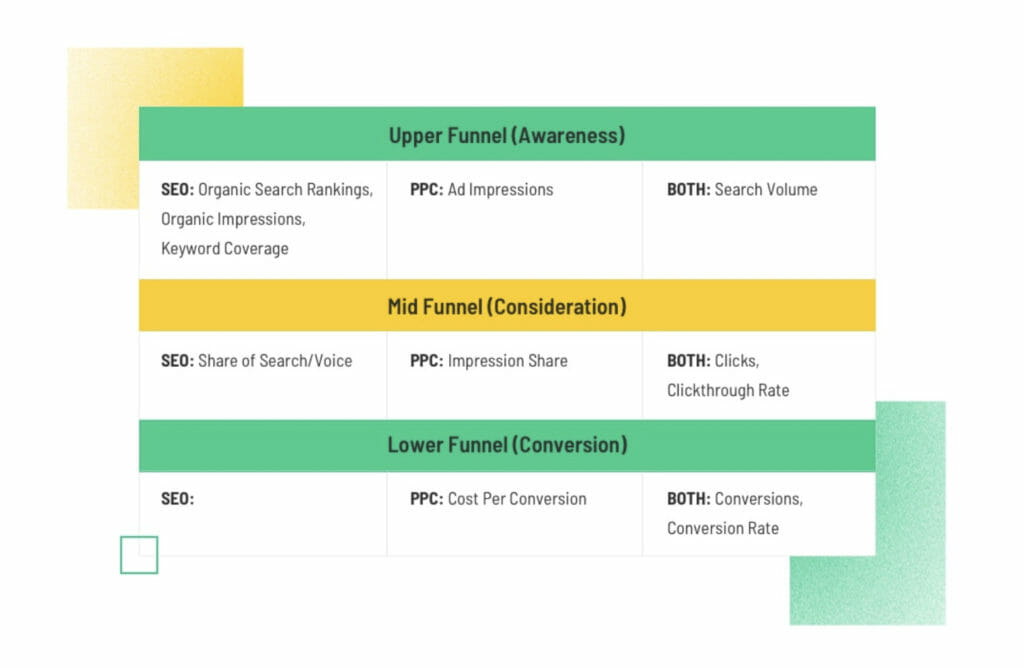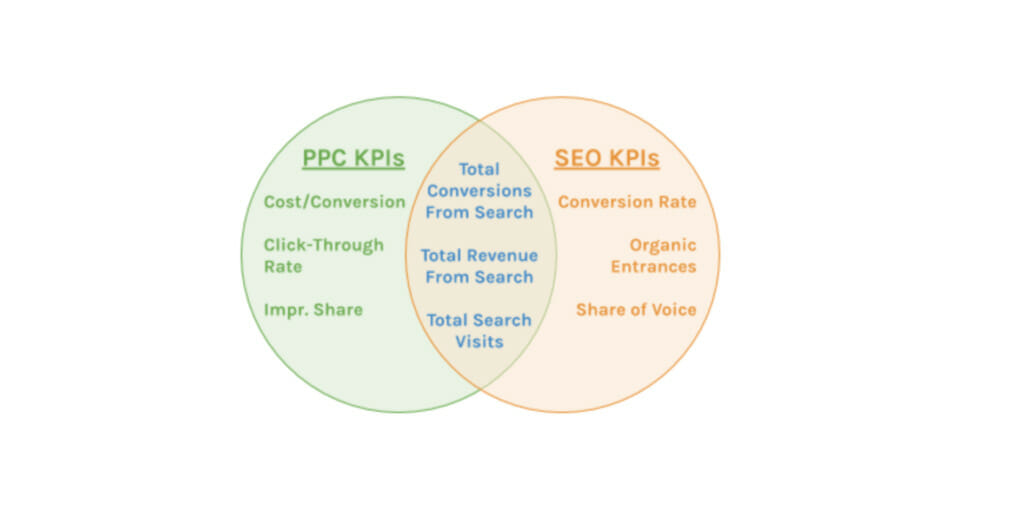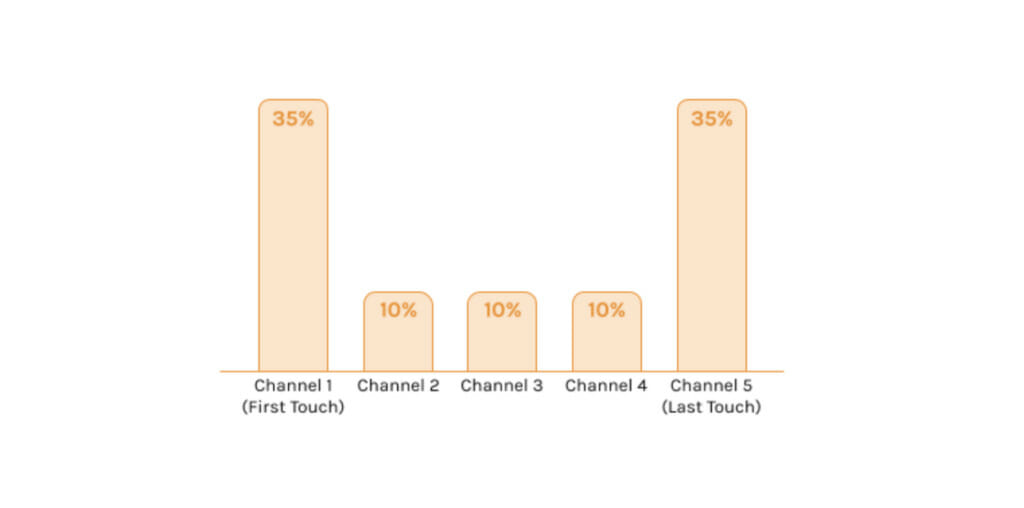You wouldn’t hire a brain surgeon to treat your heart condition. Different conditions require different specialists. It’s the same for search engine marketing. SEO has a role. PPC has a role. And, like holistic medicine, they work best when tightly integrated.
Easier said than done. Too often, marketers find themselves managing multiple agencies or internal teams, each of which is trying to accomplish their goals. The result is an inefficient, ineffective strategy.
Deeply integrated teams, in contrast, deliver:
- Streamlined communication across multiple teams, allowing you to play the role of air traffic controller rather than carrier pigeon.
- Clear expectations to ensure agency partners strategize effectively, with a high degree of accountability and without a self-preservation bias.
So how do you get there? Ask the following six questions to help SEO and PPC teams collaborate—and achieve better results than either could on their own.
Table of contents
- 1. Are SEO and PPC teams communicating effectively and sharing insights?
- 2. Are we able to create incrementality across channels?
- 3. Do we have a single source of truth for conversion and performance data?
- 4. Are we properly valuing each channel, or is one team taking too much credit?
- 5. Are test plans shared across teams to minimize variables?
- 6. Is reporting integrated or presented in channel-specific silos?
- Conclusion
1. Are SEO and PPC teams communicating effectively and sharing insights?
SEO and PPC teams that don’t communicate effectively (or at all) achieve less.
For example, our PPC team discovered fast-moving trends during the onset of COVID-19 for an events management company. Search volume dried up overnight for generic queries like “summer concerts in Richmond, VA,” as well as branded events that had been canceled.
Shortly thereafter, we discovered a corresponding increase in paid search queries for “things to do during quarantine in Richmond, VA.” The PPC team noticed the changes in search behavior and informed the SEO team so they could start creating relevant content to position the client ahead of the trend.
The first step is to establish communication channels between teams and set expectations about when and how to use them. Focus less on the tools (e.g., Slack vs. email) and more on the integration of existing workflows and communication paths.
In pre-COVID days, our SEO and PPC teams sat in close proximity, so conversations could naturally flow between them. Now that we’re remote, we share threaded conversations in Basecamp (our project management tool of choice) so both teams are aware of the others’ activities.
Encourage your teams to over-communicate. Response times are a critical factor to address market change; prioritize speed over formality. It may not be possible or necessary to have everybody on each phone call or impromptu discussion. We share client call notes internally (again, in Basecamp) to create a paper trail and immediately bring everybody up to speed.
Not sure who needs to be included in each conversation? I prefer the RACI model to determine who is Responsible, Accountable, Consulted, and Informed in cross-functional projects.
We catalog those roles—along with stakeholder info—in a couple of places:
- The team for each account team is in the description field of each client’s Basecamp project: PPC analyst(s), SEO analyst(s), manager with oversight/relationship responsibility, and the original sales team member who brought the client on board.
- We maintain a list of primary client points of contact and their senior stakeholders that sign off on budgets, strategic shifts, or might be likely to bring in other partners. This allows us to keep them informed of any large-scale changes to the account and get involved in planning conversations earlier.
Encourage your SEO and PPC teams to communicate directly so that you’re not the bottleneck. Think of yourself as an air traffic controller (Scenario 2) rather than a clearinghouse for all communication (Scenario 1).

You want to be in the loop but not bear the responsibility of passing messages and requests between teams or agencies.
Watch out for turf wars and ensure everyone is accountable for shared outcomes. Managing multiple SEO and PPC teams can result in bias or friction between teams. One way to minimize bias is to set shared goals (e.g., a top-line conversion or revenue target) and recognize both teams’ contributions—regardless of which channel generated the most conversions in a given period.
It’s never an even 50/50 split of effort or results between SEO and PPC teams. Even if one team is contributing more than the other, you still need to share data and encourage collaboration—even if it’s a zero-sum game (i.e. one team gets more resources/attention at the expense of the other).
It’s the same way with my family. I have two kids with very different skills, strengths, and weaknesses. I have to customize my parenting approach and expectations to get them to work together, accomplish their own goals, and still contribute meaningfully to the greater good of the family unit.
Another option is to unite against a common threat or competitor. The real enemy is the competition, not other teams or agencies. The competitive threat can inspire people to do their best work but may also lead to tunnel vision. (We have some clients who obsess over their competitors’ activity, which isn’t healthy.)
2. Are we able to create incrementality across channels?
I’ve seen SEO teams dominate rankings for highly competitive keywords only to be cannibalized by expensive ad clicks because nobody told the PPC team to conserve that budget for less-expensive battlegrounds.
In our experience, the combination of SEO and PPC always outperforms one or the other—if strategies include shared goals and contributions from each team.
Develop an integrated strategy with shared goals that includes input and expectations for both teams. SEO and PPC have inherent strengths and weaknesses, and there is no clear winner in the debate about which is better. But the results from a combined strategy can far exceed what each channel contributes on its own.
Establish priorities for PPC and SEO based on your conversion goals, competition, brand awareness, and internal resources:
- If your competition has a huge head start in SEO, you may need to shift more budget to PPC to gain a foothold until your SEO strategies generate enough traffic and conversions to reallocate PPC budget.
- Your SEO and content strategy may be on point but could use a boost from paid social to promote new content to decision makers and thought leaders.
- Search ads may be extremely competitive, with cost-prohibitive CPCs. The SEO team may be able to identify and target opportunities to win rich snippets or other SERP features that help your brand stand out.
Review your SEO and PPC budget allocations with a focus on macro-level goals at least once a quarter. Annual budgeting cycles are too infrequent to keep up with the shifts in digital marketing.
Prioritize the biggest opportunities first and don’t be afraid to dial back spending in unproductive areas. Your analysis should include media spend, creative production costs, software/technology costs, staffing, and agency fees.
If your cost per acquisition from PPC is well inside your target range, why wouldn’t you invest more if there’s room to grow? We often adjust the ratio of budgets and resources for SEO and PPC as part of larger strategic prioritization discussions with clients.
3. Do we have a single source of truth for conversion and performance data?
Get your teams on the same page and measure performance consistently across channels. We’ve had clients report SEO metrics from Adobe Analytics, while PPC metrics came from Google Analytics (because of its native integration with Google Ads).
Needless to say, it was nearly impossible to reconcile the discrepancies between the two data sources. It was oranges and apples. Neither team could claim success until everybody could agree on the methodology.
There will always be discrepancies across analytics and media platforms. By “single source of truth,” I mean a primary data source that all teams can use to create apples-to-apples comparisons across channels.
In the instance above, we ended up migrating Google Ads reporting to Adobe Analytics. We consciously sacrificed some of the native integrations in favor of the greater good—consistent data across channels and slightly cleaner attribution reports.
Once you have unified data, it’s easier to create macro-level goals that are shared across teams, such as total leads or top-line revenue. Each team can also have sub-goals or KPI targets that matter to their channels.
You end up with a Venn diagram that aligns shared goals and each team’s secondary metrics. This makes it easy to celebrate collective wins when the top-line goals are met—and creates room for each team to shine in their respective fields.
Often, we can’t see the full picture of a click converting to revenue, especially if the transaction occurs offline or after a long sales cycle. That shouldn’t discourage you from measuring what you can and establishing proxy metrics somewhere higher in the funnel to correlate to future sales.
4. Are we properly valuing each channel, or is one team taking too much credit?
Now that your SEO and PPC teams have shared goals, it’s time to define an attribution model. Picking an attribution model is tough, even in (hypothetical) scenarios with perfect data and visibility into the full customer journey.
In most cases, we advise “picking and sticking” with the most reasonable attribution model for your business. Even if it’s not perfect, it allows for trend analysis and comparison to other time periods and acquisition channels. Unless you have a compelling reason and enough data to customize your model, a simple U-shaped model works fine in most cases.
Once you select a model, you can evaluate your SEO and PPC teams’ performance more thoroughly and give credit where credit is due. Usually, this leads to shared wins and more reasons to celebrate the contributions from both teams.
Don’t just look at aggregate performance by channel. Look at contributions to your goals by audience segment, device type, campaign type, and any other variable that might lend insights. There are nuggets of useful data buried a layer or two beneath the surface.
Here are a couple common scenarios:
- Brand campaigns in PPC often drive more last-click conversions, while non-brand might appear less effective unless you realize they contribute a lot of assisted conversions higher up in the funnel. Without attribution data, a marketer may be fooled into cutting spend on non-brand PPC keywords that contribute significantly to downstream conversions from organic, branded keywords.
- SEO-driven content strategies can produce more upper-funnel traffic for unbranded keywords that ultimately convert through brand keywords in PPC. Your attribution data exposes this opportunity to save PPC costs by diverting spend on the unbranded keywords elsewhere.
5. Are test plans shared across teams to minimize variables?
Your SEO and PPC teams should regularly test their campaigns, content, and on-site conversion elements to drive more sales and leads from your existing visitors. However, you can easily end up with data integrity issues and invalid results if these tests aren’t planned in unison.
Here’s an all-too-common example. Your SEO team experiments with changes to a key service page to improve conversion rates. Your PPC team, unaware of the SEO team’s test, runs their own experiment in Google Ads to drive more paid traffic to the same page as a landing page test.
The changes in traffic volume, visitor segments, and visitor intent could skew the results and make it impossible to compare data before and after the test period.
To prevent this, ensure your teams share test plans in advance so they can look for potential overlaps in:
- Test hypotheses and testing tools;
- Test audiences or segments in your control vs. experiment groups;
- Website elements being tested (e.g., CTAs, navigation elements, etc.);
- Content and/or pages on the site that may be added, changed, or removed;
- Updates to the conversion funnel, such as CTAs at various stages of the journey.
Our test plans are annotated in Google Analytics, shared in Basecamp before being presented to a client, and referenced in internal meetings so other teams can stay abreast of the results and timelines.
6. Is reporting integrated or presented in channel-specific silos?
By now you have shared goals, cross-team communication, and integrated strategies across your SEO and PPC teams. Feels great, right? It would be a shame if your agencies’ reporting didn’t harmonize as well.
Too often, we see SEO and PPC metrics presented separately rather than side by side. Even worse, reporting from separate teams or agencies can be packaged in entirely different formats! This places the burden on the reader to bounce back and forth to compare results and look for opportunities.
It’s nearly impossible to separate the high-level outcomes with intertwined channels like PPC and SEO. The reporting narrative (executive summary, voiceover, or data story) needs to provide a complete picture and build on each channel’s work.
When we report results where the combined teams met the shared goal but, say, SEO accelerated while PPC fell behind, we explain that context so report readers can understand the relationship between the two channels and develop a holistic plan to course correct.
Integrated reporting forces a dialogue between SEO and PPC teams before drawing any conclusions and while crafting reports or analysis. We often see changes in performance across channels that might go unexplained or incorrectly attributed if one team isn’t aware of the outcomes of the other team (e.g., a branded paid search campaign tanks organic homepage visits).
What seems like an extra layer of communication is actually an underused way to become solution-focused, rather than taking undue credit or introducing bias.
Conclusion
Hiring multiple agencies or building separate SEO and PPC teams in-house can create friction and turf wars if not managed properly.
Your job title may include marketing, but your functional role as air traffic controller is essential for ensuring your teams can work smarter, not harder, to achieve your goals.
Ask—and get answers—to these six questions:
- Are SEO and PPC teams communicating effectively and sharing insights?
- Are we able to create incrementality across channels?
- Do we have a single source of truth for conversion and performance data?
- Are we properly valuing each channel, or is one team taking too much credit?
- Are test plans shared across teams to minimize variables?
- Is reporting integrated or presented in channel-specific silos?










Especially useful in a marketing agency – Thanks for sharing!